Anthropology
Related: About this forumWell worth the time reading, for anyone unacquainted with ancient (3,000 B.C.) S.American societies.
I just stumbled across this and have to share it with anyone who hasn't read much on Andean prehistoric complex cultures in the Americans which have ALWAYS been ignored in general by general U.S. American interest:
Norte Chico civilization
The Norte Chico civilization (also Caral or Caral-Supe civilization)[NB 1] was a complex pre-Columbian-era society that included as many as thirty major population centers in what is now the Norte Chico region of north-central coastal Peru. The civilization flourished between the fourth and second millennia BC, with the formation of the first city generally dated to around 3500 BC, at Huaricanga, in the Fortaleza area.[1] It is from 3100 BC onward that large-scale human settlement and communal construction become clearly apparent,[2] which lasted until a period of decline around 1800 BC.[3] Since the early 21st century, it has been established as the oldest-known civilization in the Americas.
This civilization flourished along three rivers, the Fortaleza, the Pativilca, and the Supe. These river valleys each have large clusters of sites. Further south, there are several associated sites along the Huaura River.[4] The alternative name, Caral-Supe, is derived from the city of Caral[5] in the Supe Valley, a large and well-studied Norte Chico site. Complex society in Norte Chico arose a millennium after Sumer in Mesopotamia, was contemporaneous with the Egyptian pyramids, and predated the Mesoamerican Olmec by nearly two millennia.
In archaeological nomenclature, Norte Chico is a pre-ceramic culture of the pre-Columbian Late Archaic; it completely lacked ceramics and apparently had almost no visual art. The most impressive achievement of the civilization was its monumental architecture, including large earthwork platform mounds and sunken circular plazas. Archaeological evidence suggests use of textile technology and, possibly, the worship of common god symbols, both of which recur in pre-Columbian Andean cultures. Sophisticated government is assumed to have been required to manage the ancient Norte Chico. Questions remain over its organization, particularly the influence of food resources on politics.
Archaeologists have been aware of ancient sites in the area since at least the 1940s; early work occurred at Aspero on the coast, a site identified as early as 1905,[6] and later at Caral further inland. In the late 1990s, Peruvian archaeologists, led by Ruth Shady, provided the first extensive documentation of the civilization with work at Caral.[7] A 2001 paper in Science, providing a survey of the Caral research,[8] and a 2004 article in Nature, describing fieldwork and radiocarbon dating across a wider area,[2] revealed Norte Chico's full significance and led to widespread interest.[9]
More:
https://en.wikipedia.org/wiki/Norte_Chico_civilization
Remnants of the cultures:
![]()
To Build An Empire, Hold The Anchovies
February 26, 201311:54 AM ET

To Build An Empire, Hold The Anchovies
February 26, 201311:54 AM ET
Megalomaniacs, consider yourselves warned. Anchovies will not help you build your empire. To rule long and prosper, serve corn.
That's the word from archaeologists who say they've solved a mystery that has been puzzling their colleagues for the past 40 years: How did some of the earliest Peruvians manage to build a robust civilization without corn — the crop that fueled other great civilizations of the Americas, like the Maya?
The Norte Chico people, who lived some 5,000 years ago, built a thriving civilization — but from the archaeological evidence previously available, it looked like they did it solely on anchovies. And anyone who has ever nibbled an anchovy on a pizza knows there's not a lot of meat on those tiny bones.
Would that have given the Norte Chico enough oomph to build the monumental architecture they left behind, including dozens of large communities with huge earthen platforms and circular ceremonial plazas, some 40 meters across?
More:
https://www.npr.org/sections/thesalt/2013/02/25/172896292/to-build-an-empire-hold-the-anchovies
~ ~ ~
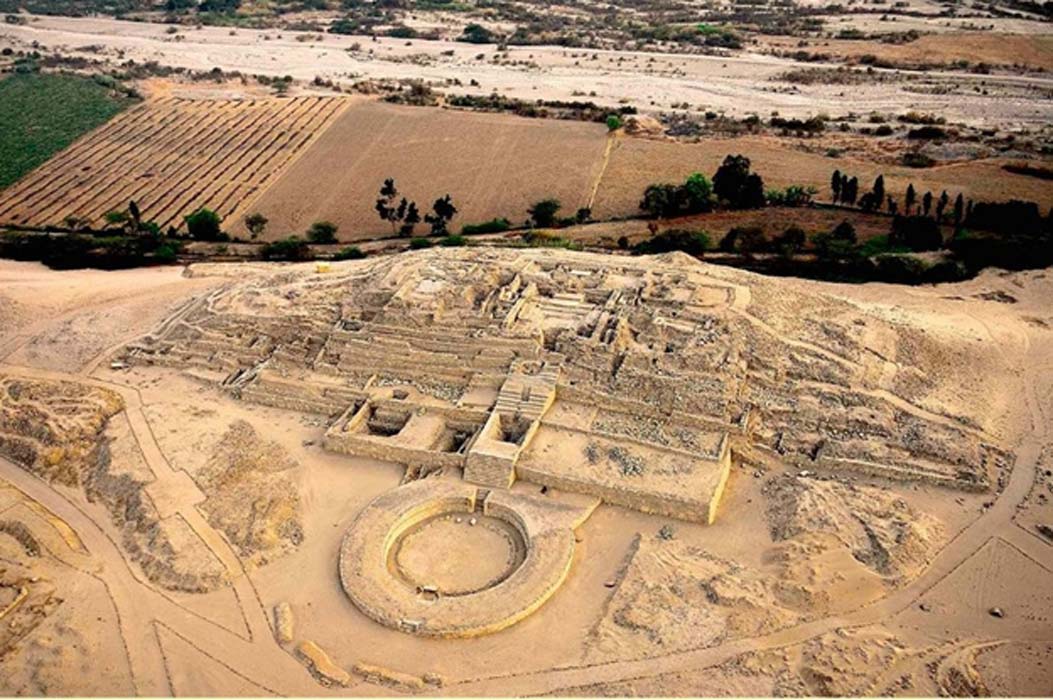
9 JULY, 2019 - 17:25 DHWTY
Norte Chico: The First Civilization in the Americas?
The Norte Chico Civilization was an ancient civilization/complex society belonging to the Pre-Columbian era. This civilization flourished in Peru about 5000 years ago, and is believed to be the oldest known civilization to have existed in the Americas.
The Norte Chico Civilization is notable today for its monumental constructions, including massive ceremonial pyramids and complex irrigation systems. This ancient civilization lasted until around 1800 BC, after which the settlements were abandoned.
Located north of Lima, Peru, the Caral-Supe settlement was the ancient home of the Norte Chico people, a civilization almost as old as the Egyptians.
Courtesy of Chris Kleihege
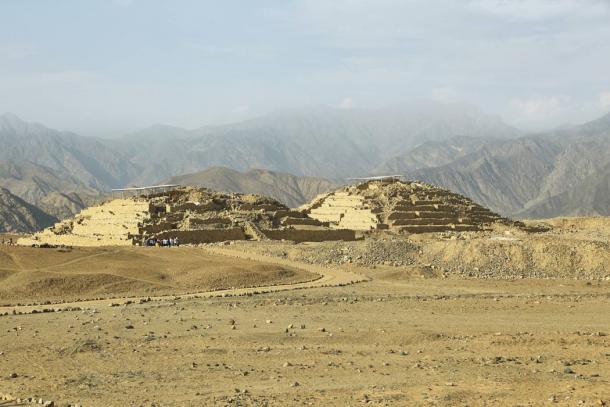
Pyramids at Caral, Supe Valley, Peru. ( estivillml /Adobe Stock) The complexity of the Norte
Chico Civilization may be seen in the monumental works that they left behind, especially
their ceremonial pyramids.
Location of Norte Chico Civilization Sites
The sites of the Norte Chico Civilization are situated around 200 km (124.27 miles) to the north of Lima, in what is today the Norte Chico region of north-central coastal Peru, near Supe, Barranca province. This civilization is also known as the Caral / Caral-Supe Civilization, as its best-studied site is Caral in the Supe Valley.
Based on radiocarbon dating, it has been suggested that the formative period of the Norte Chico Civilization was sometime during the 4th millennium BC. The civilization’s greatest period of expansion, however, belongs to the 3rd millennium BC.
The dating of the Norte Chico Civilization shows that these inland sites were developing around the same time as their coastal neighbors. This is important, as it challenges the conventional view that all early civilizations in Peru and the rest of South America began by the sea as coastal settlements.
However, a close inter-dependent relationship between the peoples of the coast and the Norte Chico Civilization also existed. Trade is believed to have been based on fish from the coast being exchanged for cotton (for the production of fishing nets) from the interior.
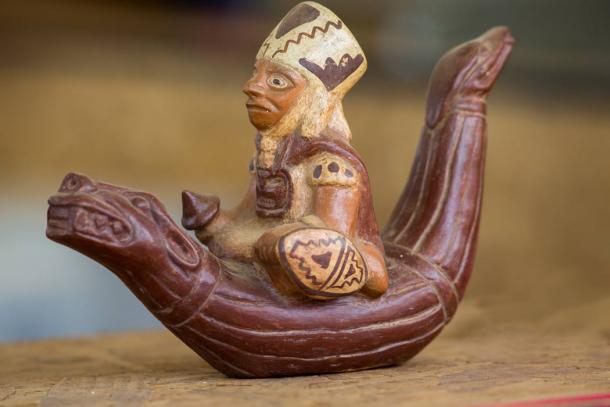
More:
https://www.ancient-origins.net/ancient-places-americas/norte-chico-civilization-ancient-peruvian-civilization-or-complex-society-021445
~ ~ ~
Neighbouring city of ancient Caral at risk
March 23rd, 2010
Authorities from the local district of Barranca are investigating reports that part of Era de Pando, the ruins of a city belonging to the civilisation that built the nearby capital of Caral, have been occupied by local farmers with the intent of destroying a pyramid to build a reservoir to water the crops they are planting in the ancient site’s plaza.
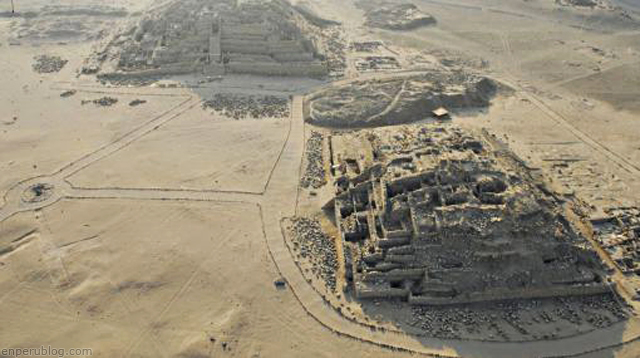
Just one month ago archaeologists had attempted to work in the area but were threatened with hostility by the illegal occupiers, forcing them to request protection from an as yet unresponsive police service.
The association of farmers defended their actions and intentions by stating they had acquired ownership of the land and have deeds. Authorities contest however that the archaeological site was declared national heritage in 2000, a time when there were no occupiers.
. . .
Archaeological Terrorism
Caral is not the only site under threat by illegal occupiers. The most vicious have been squatters at the Bosque de Pomac site, who are formed by heavily-armed violent locals who kill endangered species, burn down some of the last remaining tracts of dry forest, dig holes in pyramids and murder police officers attempting to enforce the law.
The site is located in the lower half of the Supe valley on the northern side of the river and at the mouth of a dry dusty gully just metres above the fertile valley floor. Its size and distribution tell us it was an urban settlement rather than any type of ceremonial centre.
Authorities, who will inspect the site tomorrow at 10am, state that other archaeological sites in the valley are also under threat. The similarly aged site of Lurihuasi is being built upon with
http://enperublog.com/2010/03/23/neighbouring-city-of-ancient-caral-at-risk/
~ ~ ~
Discover Ancient Caral – The City That Time (almost) Forgot
15 Jul, 2016
A hidden UNESCO treasure only a few hours out of Lima, Caral is an ancient citadel which predates the Incas by 4,000 years. Time may have forgotten the reputed ‘Oldest City in the New World’ for a while, but it has now rediscovered it with gusto. So come along as we explore what is, thus far, the oldest city ever discovered in the American continent.
The mere mention of ‘great ancient civilizations’ is usually enough to conjure up images of grandiose Roman amphitheatres, flamboyant Chinese dynasties, Egyptian pyramids, and awe-inspiring Greek temples. Yet what many people don’t know, is that one of the oldest civilization of modern man arose from the arid desert sands of modern-day Peru. Caral is the incredible legacy the Norte Chico culture left behind: an archaeological masterpiece which was once a bustling metropolis comprising pyramids, temples, houses, amphitheatres, and ornate plazas. In 2001, UNESCO named Caral ‘the oldest city in the Americas’, almost 1,000 years after the first signs of its existence were detected by famed German archaeologist Max Uhle. Not since 1911, when American Hiram Bingham stumbled upon mystical Machu Picchu, has a more significant discovery emerged from Latin America.
Finally open to the public and set to become one of Latin America’s foremost historical attraction, the Ancient city of Caral is a marvel not to be missed when visiting Peru.
Caral: an unrivalled discovery that boggled the scientific world
Caral wasn’t just built 4,000 years before the revered Inca city of Machu Picchu, it was also built four millennia before the great Khmer Empire’s Angkor Wat, three millennia before the Romans built their colossal Colosseum, and even half a millennia before the mighty ancient Egyptians erected their Pyramids at Giza. This ancient city is so old that no pottery has ever been found there. Ceramic had not even been invented when it was built. The mounds which we now know to be pyramids were for decades thought to be natural forming hills by previous surveyors in the early 1900s, and this is primarily the main reason why the city remained hidden for so long. Moreover, when initial carbon-dating was carried out, it was summarily disregarded. Many thought it preposterous that the site could be 4,500 years old. Well, so much for that theory.
With further testing, Caral turned out to be 500 years older than that still.
Yet it isn’t only the age of the structures at Caral that is utterly impressive. What anthropologists find most fascinating are the in-depth stories the city tells of human kind’s first attempts at creating a centralised tiered society, and developing the credo that working together for a common goal is more prosperous in the long run.
. . .

More:
https://www.chimuadventures.com/blog/2016/07/discover-ancient-caral/
Bernardo de La Paz
(48,961 posts)Judi Lynn
(160,450 posts)Glorfindel
(9,719 posts)Judi Lynn
(160,450 posts)Sunlei
(22,651 posts)What always surprised me were the miles around these sites full of rubble/rocks, plowed fields with piles of rubble push to the sides. All the 'locals' in possession of some small relics and bits of artwork, pottery items.
These were huge civilizations and so much is totally lost. Built upon or perhaps still buried for future discovery.
I think these people traveled the entire route from the tip of south America all the way along the coastlines perhaps as far as Russia across the bearing landmass & back again. I don't believe they just walked these vast distances either. They had to have used the seas/rivers and maybe even rode horses for thousands of years longer then currently 'believed'.
wnylib
(21,341 posts)dating indicate a much longer time for people in the Americas than the old Clovis theory originally suggested (11,000 years ago). How much longer? Depends on who you ask. Most estimates that I've seen suggest at least 20,000 years ago. Probably more, IMO.
I don't buy the Clovis theory of the first people entering America only by land at Beringia, and then the interior of North America only when an ice free corridor opened up. Humans reached Australia by boat at least 50,000 years ago.
Beringia did not form overnight. As more land gradually was exposed, people who were adapted to a coastal marine life probably followed the coastlines. They could have bridged the gap between Asia and North America by boat at a much narrower Bering Strait before the two continents were fully connected. Or, they could have followed the Aleutian Islands since they were connected to each other and almost to the Kamchatka Peninsula in Asia, which in turn was connected to islands leading to Japan when glaciation exposed and connected more land. This would have been farther south of the Arctic region.
I think the earliest people entering N.America came by boat. Some continued down the Pacific coastline. Others followed rivers, streams, and lakes inland, south of the glaciers, where melt runoff provided abundant sources of food and fur animals at watering sites. Meadowcroft Rock Shelter in southwest PA is an example of such a place, dating back to 14,000 years ago and likely (but disputed) earlier dates at lower layers.
The earliest people could have arrived as far back as 30,000 years ago, although there is no accepted evidence of that, yet.
Regarding trade with eastern Russia and the rest of east Asia, maybe it happened between Alaska, the Pacific Northwest, and Asia. There is some genetic evidence of "backflow genes" in that region. But not beyond that area.
No evidence of those early Americans riding horses. Horses originated in America and were hunted along with other mammals by humans. Those early horse forms were not like the ones tamed for riding thousands of years later in Asia. Horses migrated into Asia across Beringia before the glaciers melted, and evolved further on the open Asian steppes before becoming tamed for riding. By the time of Columbus, all horses were extinct in the Americas and were brought here by Europeans.
Judi Lynn
(160,450 posts)which may illuminate things far more than we know now, like the fantastic ground-penetrating, jungle penetrating cameras being created and refined, from seeing things buried under the sand, in Egypt, to innumerable "lost" cities in the Americas.
Hope you will be able to return to see newly uncovered places to add to your list.
Really envy your experience with the ones you've already visited. The images online are fascinating.
Creepy realizing how many locals have made off with meaningful pieces of the prehistoric civilizations. Happens all over the world. They just can't help themselves, apparently.
wnylib
(21,341 posts)in less detail than now available.
Seems, from one old article that I read, the stone buildings there influenced architecture in later cultures of America.
The similarities in shape between the Caral pyramids and much later ones in Mesoamerican civilizations suggests to me a long-lasting cultural influence beyond the Caral region. Was there contact between Peru and Mesoamerica? Or, is the Amazon region and river the common denominator? The people of Caral knew abiut Amazonian animals. Did the founders of the Caral culture originate there or only travel there for trade or exploration of the Amazon River basin?
The Amazon rainforest climate is similar to regions of Central America, providing a possible common denominator connection between Peru and Mesoamerica.
So maybe the Amazon Basin or the Caral region of Peru were catalysts for later civilizations in the Americas. But, if so, any connection did not extend to the development of writing and the complex mathematics and astronomy that.existed later in Mesoamerica. The civilizations of Peru did not have writing.
Judi Lynn
(160,450 posts)Love your post, touching on so many important areas.
I just took a quick run to google to see if anything jumped out in a search for peru ancient civilization astronomy and this is the first thing up:
august 20, 2018 cusco, nature, peru
Inca Astronomy: How the Incas Saw the Stars
Inca astronomy played an important role in the civilization's fascinating belief system.
by Hendrika Janssen

Artwork representing constellations observed by the Incas is on display at Qorikancha in Cusco.
Gazing up at a starry night sky is nothing short of magical. People have long been fascinated with stars, and have attempted to find meaning in what they saw in the sky. The Inca civilization in Peru placed great importance on astronomy. They were the only culture in the world to define constellations of both light and darkness. The Incas not only identified constellations and individual stars, but they also assigned each a purpose. They believed that everything in and around our world was connected.
The Complex Inca Belief System
The Inca flourished in the Andes Mountains in South America from the 12th to 15th centuries. They had a grand empire stretching from present-day Colombia to Chile. Worship was very important to them and they had a complicated religion, closely linked to astronomy. The Inca worshiped various Gods, including Viracocha (the creator), Inti (the sun), and Chuqui Illa, the God of Thunder. They also worshiped huacas, spirits that were believed to inhabit any remarkable phenomenon, including large boulders, trees, streams or waterfalls.
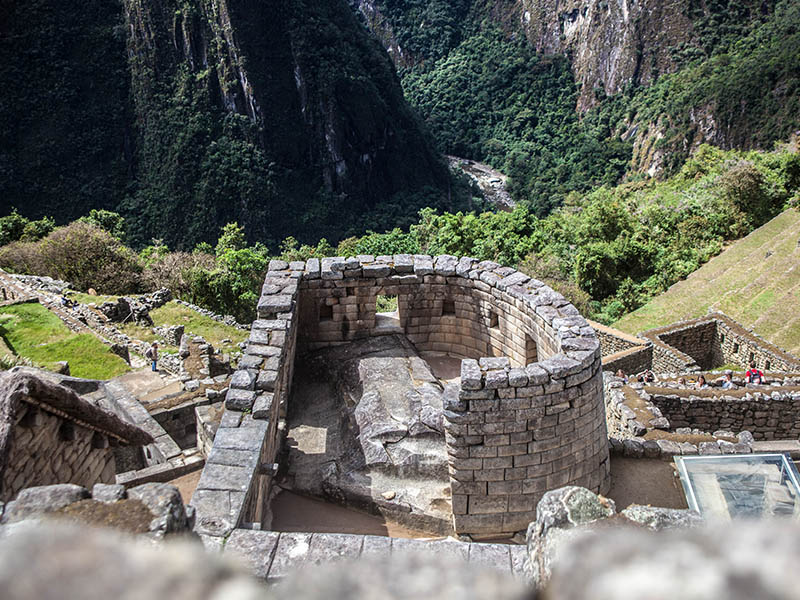
The Temple of the Sun at Machu Picchu likely served as a solar observatory and sacred site where high Inca priests performed rituals.
In general, the sky was very important to the Inca. Both the moon and sun were seen as gods and they built extravagant pillars and temples with great precision so that these “heavenly bodies”, like the sun, would pass over the structures or through windows on specific days, like the summer solstice. The most crucial events for the Inca generally involved the rising and setting of the sun, moon, and stars.
More:
https://www.peruforless.com/blog/inca-astronomy/
~ ~ ~
I've never seen this information, haven't read the whole article but I will in a moment.
There's so much to find out, isn't there? Not enough time in any day, by any means.
So good to see your thoughts. Thank you.
wnylib
(21,341 posts)a main interest in the cultures of the Americas.
i wasn't aware of the extent of the Inca interest in astronomy. They must have had a system of telling time, e.g. calculating and numbering months, in order to create the sites that let them know when to plant. So they had a complex numerical system, which we know from their use of quipus. I have no idea how to use one, but as far as I know, the Inca system did not have zero, as the Mayan system did. And nobody, not the Incas, Europeans, or Asians, had the year calculated as precisely as the Mayans.
The linked article mentions that the Inca differed from European concepts of constellations because the Incans considered the constellations as living beings that were part of the interconnectedness of life (a theme shared by many Native cultures). By contrast, it says that European constellations were inanimate and not connected to people or the rest of the world. But that overlooks the practice of astrology, which reached Europe from Middle Eastern "wise men." Astrology holds that the planets and stars have a strong influence on life on earth.
The people of each region develop their own adaptations to their environments and their own customs and cultures, but often are influenced by the developments of previous cultures or separate contemporary ones.
I long believed there was a trade connection between Mesoamerica and North America which spread corn (maize) agriculture and aspects of Mesoamerican culture to the Mississippi River basin and its tributaries. Now I suspect that some aspects of Mesoamerican culture originated in the Amazon basin which influenced the people of Peru to the west and people of Mesoamerica to the north.
Judi Lynn
(160,450 posts)Will definitely be remembering it now you've brought it up.
So much to learn ahead of us. No doubt we have a storm of discovery as they awaken far more to what has always been here.
wnylib
(21,341 posts)and history of Spain and Latin America. Since Native cultures are a large part of the culture and history of Latin America, anthropology of the Americas was a natural minor. But I found North American Native cultures very interesing, too.
From the time of the early Spanish and Portuguese conquistadores in the Americas, there were rumors of a great, ancient civilization in the Amazon basin, but nobody ever found one. In modern times, evidence of pre-Columbian extensive agriculture and hut villages was found, but no stone architecture. None of the things we would associate with civilization were found. But the people in the region spoke of a time when there was a great city that ruled a large area. I've wondered if the city was actually farther north, a forerunner of the later Mesoamerican cities.
I wonder about it because of some similarities in a few customs and styles. The Amazon basin soil is too acidic for agriculture. Investigators found that ancient Amazonians had transported good soil and built up layers of it for growing crops. That shows some organization and sophistication in planning that would require a fairly large and unified group with a strong leader and some strong motivation. So the great city might have existed, built with perishable wood instead of stone.
The people of Caral (and the Incas much later) were familiar wirh Amazonian animals and crops. There are flat-topped temple pyramids in Peru and in Mesoamerica. Amazonia lies between these regions. Much later than Peru or Mesoamerica, there were flat-topped earthen temple pyramids in North America, and also some of the Mesoamerican crops, like Maize.
So, I'm not an anthrpologist. I only minored in the subject. But it looks to me like there might have been an early Amazonian society that contributed concepts, if not technologies, to places like Peru and Mesoamerica.